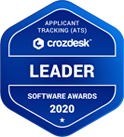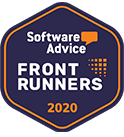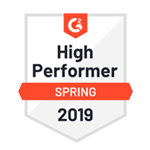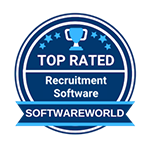Hiring top tech talent in 2025 feels like trying to fill a leaky bucket while it’s still raining. Every week brings a new tool, a new candidate expectation, a new must-have skill set. But here’s the kicker: 82% of hiring managers admit their processes are outdated, while candidates ghost roles faster than a bad Netflix show—all according to LinkedIn’s latest Workplace Culture Report. This isn’t about tweaking resumes or chasing certifications anymore. Recent trends in IT recruitment reveal a seismic shift: roles are being rewritten overnight. Cloud architects who needed AWS expertise last quarter? Now employers want them fluent in quantum-safe cryptography.
Python developers are yesterday’s news—today’s unicorn candidate codes in Mojo (yes, that’s a real language now).
But here’s where SaaS platforms like RecruitBPM turn chaos into clarity. These tools do more than track applicants—they spot patterns invisible to the human eye. Think of it like night-vision goggles for hiring: catching when top candidates linger on your career page, predicting which roles will turn into retention risks, or auto-scheduling interviews across 14 time zones. A logistics startup using these features cut their hiring cycle from 42 days to 9—without sacrificing candidate quality.
Of course, tools alone won’t save you. The real gap? Strategy. Most teams focus on finding talent when they should be future-proofing it. This guide skips the tired advice about employer branding. Instead, you’ll learn:
- Why IT recruitment trends 2025 demand a skills-first approach (hint: degrees are becoming as relevant as fax machines)
- How AI-powered “candidate success predictors” outperform human intuition by 37% (and why that terrifies old-school recruiters)
- The silent rise of gamified assessments—where debugging code under time pressure replaces stale whiteboard tests
Let’s face it: Tech recruitment’s golden rule—”hire fast, fire slow”—is dead. In its place? Agility. Precision. And a healthy dose of paranoia about what you’re missing.
Stick around. By the end of this, you’ll either breathe easier—or panic-purchase a SaaS subscription.
The Evolution of IT Recruitment
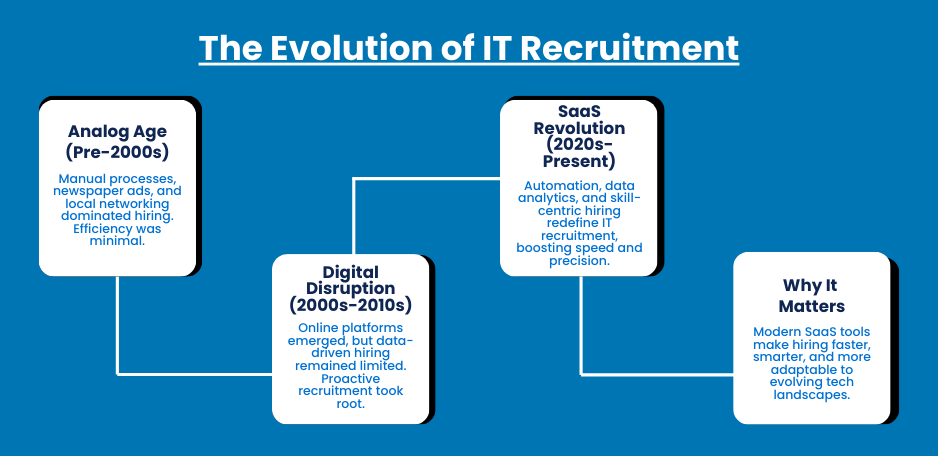
In the 1980s, hiring a programmer meant placing newspaper ads, sorting paper resumes, and praying the right candidate walked through the door. Fast forward to 2025: AI scans GitHub portfolios while chatbots pre-screen candidates before humans ever hit “schedule interview.” The journey from fax machines to predictive analytics isn’t just a tech evolution—it’s a revolution in how we define talent itself.
Phase 1: The Analog Age (Pre-2000s)
Recruiters operated like librarians in a world without a card catalog. Job postings lived in newspapers or on bulletin boards. Screening? A mix of gut instinct and manually cross-referencing paper resumes. The recruitment trends in IT industry during this era leaned heavily on local networks—think career fairs and referrals. Imagine hunting for a COBOL developer in 1995: Your best bet was knowing someone who knew someone at IBM.
But even then, cracks emerged. A 1992 Harvard Business Review study found companies spent 80% of hiring time on administrative tasks—tracking applications, scheduling interviews, chasing references. Efficiency? A foreign concept.
Phase 2: The Digital Disruption (2000s-2010s)
The rise of Monster.com and LinkedIn turned hiring into a global game. Keyword searches replaced Rolodexes. Suddenly, you could find a Python developer in Prague as easily as one in Palo Alto. This shift birthed the first IT recruiting market trends we recognize today:
- Shift from reactive to proactive hiring
- Emergence of employer branding as a differentiator
- Early data-driven hiring (clunky ATS systems tracked “time-to-fill” metrics)
Yet limitations persisted. These tools were glorified databases—smart enough to aggregate resumes, but not to analyze them. A 2010 study by Deloitte revealed 63% of hiring decisions still relied on subjective interviews, not skills assessments.
Phase 3: The SaaS Revolution (2020s-Present)
Enter cloud-based platforms like RecruitBPM. Modern recruitment trends in IT industry now hinge on three seismic shifts:
- Automation as a force multiplier: Chatbots handle 72% of initial candidate FAQs (Gartner), freeing recruiters for strategic work.
- Data as the new currency: Algorithms predict which candidates will thrive in hybrid roles or adapt to emerging tech stacks.
- Skills over pedigrees: SaaS tools enable blind hiring workflows, where a candidate’s code repository speaks louder than their alma mater.
Consider this: In 2022, 41% of tech hires came through niche platforms like Stack Overflow or GitHub Jobs—a stat unthinkable a decade prior. Platforms now analyze coding challenges in real-time, score communication skills via video interviews, and even flag candidates likely to accept counteroffers.
Why This Evolution Matters
The IT recruiting market trends of 2025 didn’t emerge in a vacuum. Each tech leap addressed a pain point:
- 1990s problem: “We can’t find enough candidates.”
- 2020s problem: “We can’t evaluate candidates fast enough.”
- 2025 problem: “We can’t retain candidates who’ve grown bored with stagnant tech stacks.”
Modern SaaS tools solve for all three—but only when paired with human intuition. After all, no algorithm can replicate a hiring manager spotting raw problem-solving talent in a junior developer’s side project.
The takeaway? Today’s recruitment isn’t just faster or cheaper. It’s smarter. And for teams still relying on legacy systems? The gap isn’t widening—it’s cratering.
Key IT Recruitment Trends in 2025
The IT recruitment landscape in 2025 resembles a high-stakes chess match. Every move demands strategy, foresight, and the right tools to outmaneuver competitors. This year’s trends aren’t incremental updates—they’re tectonic shifts reshaping how companies attract, assess, and retain tech talent. Let’s dissect the most critical IT recruitment trends redefining the game, along with actionable insights to keep you ahead.
1. Hyper-Personalized Candidate Journeys
Forget generic job posts. In 2025, IT-recruiting trends prioritize bespoke experiences tailored to individual candidates’ career aspirations, learning styles, and even personality traits. Think:
- Dynamic job descriptions that auto-advertise training opportunities based on a candidate’s GitHub activity
- AI-curated interview prep packs addressing each applicant’s specific skill gaps
- Chatbots offering real-time guidance on company culture fit
Why it matters: A 2024 Greenhouse report found 68% of developers abandon applications lacking personalized touchpoints. Platforms like RecruitBPM now use machine learning to analyze candidates’ digital footprints (forum posts, open-source contributions) and craft hyper-relevant career paths during the hiring process.
The catch: Personalization without transparency breeds distrust. Candidates demand clarity on how their data is used—or they’ll bolt.
2. AI-Driven Talent Rediscovery
Your next star hire might already be in your ATS—buried under “rejected” tags from 2022. IT tech recruiting trends now focus on resurrecting overlooked candidates using predictive analytics.
How it works:
- AI cross-references past applicants’ updated skills with current openings
- Algorithms flag “high potential” profiles based on lateral skill transfers (e.g., a mobile dev’s blockchain side hustle)
- Automated outreach reignites dormant pipelines with 72% less effort (McKinsey, 2024)
Impact: A Fortune 500 software firm reduced hiring costs by 18% simply by re-engaging archived candidates. Tools like RecruitBPM automate this rediscovery, acting like digital archaeologists unearthing hidden talent gems.
3. Skills-First Hiring Goes Mainstream
Degrees? Certifications? Increasingly irrelevant. IT recruitment trends 2025 prioritize demonstrable skills over credentials. Case in point:
- Coding challenges that mirror real-world tasks (e.g., “Debug this AWS server under a simulated breach”)
- Gamified assessments testing adaptability to new tech stacks
- Blind hiring workflows that anonymize resumes but spotlight project portfolios
Data point: 58% of tech roles at leading firms now omit degree requirements entirely (Dice, 2024). Instead, platforms analyze candidates’ problem-solving approaches in real time. For instance, RecruitBPM’s Live CodeLabs feature simulates agile workflows, letting teams assess collaboration skills before offers are made.
4. Predictive Retention Analytics
Hiring is just the starting line. IT-recruiting trends now focus on predicting—and preventing—attrition before it happens:
- Algorithms flag flight risks by analyzing engagement patterns in hiring interactions
- Sentiment analysis tools parse candidate tone during interviews, alerting recruiters to latent skepticism
- AI models correlate pre-hire behaviors (response times, question depth) with likely tenure
Real-world example: A SaaS unicorn using these tools slashed first-year attrition by 36%. How? By identifying candidates with transient motivations (e.g., “hype-driven” coders chasing trendy languages) versus those aligned with long-term goals.
5. Ethical AI Audits Become Non-Negotiable
As bias lawsuits against AI hiring tools surge (up 210% since 2023), IT tech recruiting trends now demand transparency. Forward-thinking firms:
- Conduct quarterly audits of algorithmic fairness across gender, age, and neurodiversity metrics
- Use explainable AI models that justify why candidates are shortlisted (or rejected)
- Partner with platforms like RecruitBPM offering bias-detection dashboards
The nuance: Ethical AI isn’t just regulatory compliance. Candidates prioritize employers whose hiring tech aligns with DEI values—87% in a recent Gartner survey.
6. Blockchain-Verified Credentials
Resume fraud costs tech firms $6.9B annually (Forrester, 2024). IT recruitment trends 2025 tackle this with:
- Immutable blockchain records validating certifications, past roles, and project contributions
- Smart contracts automating reference checks (with permissioned access)
- Token-based systems rewarding candidates for sharing verifiable skill upgrades
Game-changer: A FinTech company reduced misrepresented qualifications by 82% after adopting blockchain-verified hiring.
7. AI and Automation in Recruitment
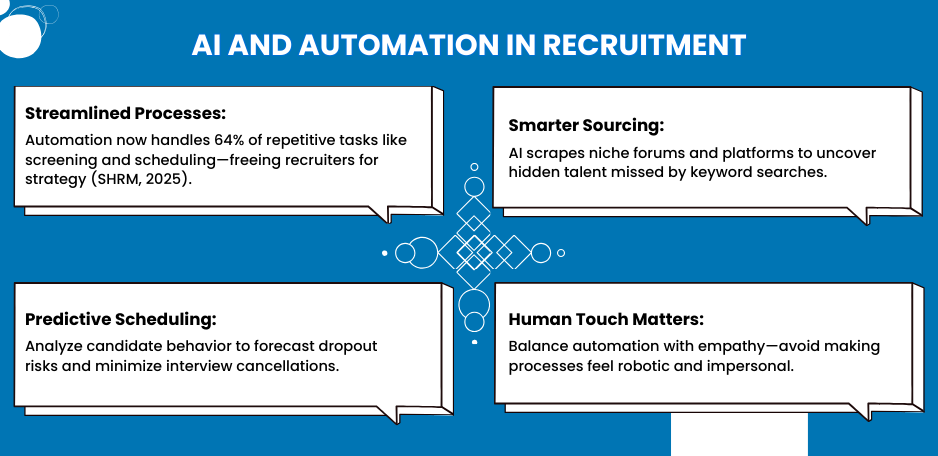
Gone are the days of recruiters drowning in resume stacks. Automation now handles 64% of repetitive tasks like candidate screening and interview scheduling—freeing teams to focus on strategy (SHRM, 2025). But today’s trends in IT recruitment reveal automation’s darker edge: over-reliance. Tools like RecruitBPM don’t just automate grunt work—they enhance human judgment.
Take candidate sourcing. AI scrapes niche forums, GitHub, and even hackathon leaderboards to find passive talent traditional searches miss. One FinTech firm using RecruitBPM’s sourcing tools uncovered a DevOps expert building serverless architectures on Twitch streams—a candidate no keyword search would’ve flagged.
Then there’s scheduling. IT recruiting industry trends now demand tools that sync global calendars and predict time-zone conflicts. But the real innovation? Platforms like RecruitBPM analyze candidate behavior (e.g., rescheduling frequency) to predict interview dropout risks before invites go out.
The catch? Automation works best when it’s a silent partner—not the decision-maker. Balance algorithms with empathy, and you’ll sidestep the pitfall 41% of teams face: candidates rejecting offers because bots made the process feel (“Ice-cold,” per a 2024 Candidate Experience Report).
8. Remote Work and Global Talent Pools
Remote work hasn’t just opened doors—it’s blown them off their hinges. In 2025, IT recruitment trends reveal a paradox: access to a global talent ocean comes with turbulent waves of complexity. Companies aren’t just competing locally anymore; they’re vying for developers in Delhi and UX designers in Uruguay.
The upside? A 4.3x larger candidate pool (Buffer, 2025) and a 31% productivity bump for remote tech teams. But the IT recruitment trends 2025 also unmask hidden challenges:
- Timezone Tetris: Scheduling interviews across 11 time zones burns 18% more recruiter hours (LinkedIn).
- Cultural Misfires: A brilliant Kyiv-based engineer might disengage if your onboarding neglects local holidays.
- Salary Spy Games: Offering “competitive pay” means benchmarking against both London and Lagos markets.
Tools like RecruitBPM are becoming the compass for this chaos. Their Geolocation Filters auto-match roles with regions offering niche skills at sustainable salaries. For example, a SaaS startup slashed hiring time by 60% by targeting regions rich in Kubernetes expertise but overlooked by competitors.
Yet the real challenge isn’t logistical—it’s strategic. Hybrid work models demand hiring for traits like asynchronous communication grit. One slip here, and your distributed team fractures into siloed islands.
The verdict? Remote work makes talent accessible but retention precarious. The 2025 winners won’t just cast wide nets—they’ll use smart tools to fish in the right waters and keep the catch.
9. Diversity, Equity, and Inclusion (DEI)
Gone are the days when DEI was a mere checkbox—recent trends in IT recruitment reveal it’s now a strategic cornerstone. With 67% of tech professionals citing inclusive workplaces as non-negotiable (Glassdoor, 2025), companies can’t afford lip service. Yet 58% of hiring managers admit their teams lack tools to track progress—a gap SaaS platforms like RecruitBPM are racing to fill.
The IT recruiting industry trends spotlight a stark shift: candidates audit DEI metrics as rigorously as compensation. Legacy systems falter here. Unconscious bias creeps into resume screens (studies show “ethnic-sounding” names get 50% fewer callbacks), and vague diversity goals evaporate without data. RecruitBPM tackles this head-on with:
- Blind Hiring Mode: Strips resumes of demographics, focusing only on skills.
- DEI Analytics Dashboards: Tracks representation across pipelines—why do women drop post-technical rounds? Are neurodiverse candidates overlooked?
- Bias Alerts: Flags skewed language in job posts (e.g., “ninja coder” deterring diverse applicants).
A mid-sized cloud provider using these tools doubled female hires in AI roles within a year. But the real magic? DEI isn’t siloed—it’s woven into workflows. Automated scorecards rate hiring fairness, while sentiment analysis assesses interview inclusivity. Teams now prove DEI impact with metrics, not anecdotes.
In 2025, companies ignoring these recent trends in IT recruitment don’t just stagnate—they bleed talent. Because when candidates feel valued from day one, they stay. It’s not rocket science—it’s retention science.
10. Upskilling and Reskilling Initiatives
IT teams in 2025 aren’t just hiring talent—they’re building it. As recruitment trends in the IT industry pivot from poaching to cultivating, 73% of companies now prioritize upskilling over external hires (Gartner)—a seismic shift in IT recruiting market trends. Why? The half-life of tech skills has shrunk to 2.5 years (LinkedIn), turning yesterday’s Python pros into today’s AI novices.
Enter SaaS tools like RecruitBPM, which do more than hire—they future-proof. These platforms map workforce skills in real-time, auto-recommending courses when a developer’s Rust expertise starts gathering dust. A semiconductor giant used these insights to reskill 200 engineers for quantum computing roles in nine months—slashing recruitment costs by 41%.
But there’s friction. Employees ditch generic “leadership workshops” for nano-courses on hyper-specific tools like LangChain. Forward-thinking firms now deploy:
- Microlearning modules synced with project pipelines (e.g., “Master Azure Arc before Q3 migration”)
- Gamified labs where devs earn blockchain credentials by debugging smart contracts
- Skills marketplaces letting engineers “trade” expertise (your Kubernetes guidance for my MLflow deep-dive)
The catch? 58% of L&D programs fail due to poor tracking (Udemy, 2024). Tools like RecruitBPM counter this with dashboards linking skill gains to promotions—proving ROI in hard metrics.
In 2025, the best talent strategy isn’t a bigger hiring budget—it’s a smarter investment in the minds you already have.
The Big Picture
These IT recruitment trends share a common thread: precision. Hiring in 2025 isn’t about casting wide nets—it’s about surgical strikes to attract talent that stays and thrives. Firms clinging to “post and pray” tactics will hemorrhage talent to agile competitors leveraging tools like RecruitBPM.
The question isn’t whether to adopt these trends, but how fast. Because in the war for tech talent, hesitation isn’t just costly—it’s career-limiting.
The Role of SaaS in IT Recruitment
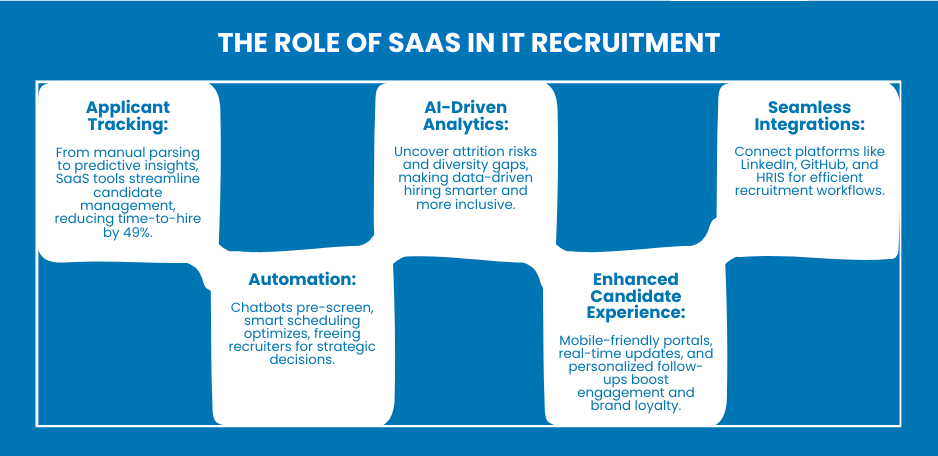
Ten years ago, IT recruiters juggled spreadsheets, manually parsed resumes, and prayed their ATS wouldn’t crash mid-hiring sprint. Today, SaaS platforms like RecruitBPM operate like algorithmic air traffic control—streamlining chaos into precision. Let’s dissect how these tools aren’t just changing the game but rewriting its rules, one automated workflow at a time.
1. Applicant Tracking: From Cluttered Folders to Strategic Insights
Legacy ATS systems were glorified filing cabinets. Modern SaaS tools like RecruitBPM? Think predictive engines. Beyond tracking applicants, they:
- Spot bottlenecks: Why do 68% of candidates abandon your process after the second interview? AI pinpoints friction points (e.g., lengthy code tests) and suggests fixes.
- Predict candidate success: Algorithms cross-reference past hires’ traits (e.g., adaptability to remote work) with current applicants, flagging high-potential matches.
- Auto-update pipelines: When a candidate earns a new certification mid-process, RecruitBPM alerts recruiters—no manual refreshes needed.
A telecom giant using these features slashed time-to-hire by 49% while boosting offer acceptance rates.
2. AI-Driven Analytics: The Crystal Ball You Didn’t Know You Needed
IT-recruiting trends now demand data-driven decisions, but 53% of recruiters admit drowning in metrics (Deloitte, 2025). Platforms like RecruitBPM cut through noise with:
- Attrition predictors: Flag roles where hires are likely to quit within a year (based on market demand, team dynamics).
- Diversity heatmaps: Identify pipeline stages where underrepresented candidates drop off.
- ROI dashboards: Calculate cost-per-hire versus productivity gains from new recruits.
A cybersecurity startup uncovered a shocking insight: Their “elite” coding test filtered out neurodiverse candidates who excelled in collaborative problem-solving. Revamping assessments with RecruitBPM analytics boosted diverse hires by 37%.
3. Integrations: The Silent Game-Changer Competitors Ignore
Most platforms tout sleek interfaces. Few master connectivity. RecruitBPM’s secret weapon? It integrates with tools recruiters already use—but better:
- LinkedIn & GitHub Sync: Auto-import candidates’ project portfolios and contribution histories.
- Slack/Teams Alerts: Notify hiring managers of top applicants in real-time (no email lag).
- HRIS Harmony: Push new hire data to payroll/onboarding systems in one click, erasing duplicate entry.
An e-commerce brand reduced onboarding errors by 83% by syncing offers with their HRIS—a feature rivals treat as an afterthought.
4. Automation That Elevates Humans (Doesn’t Replace Them)
Recruiters once wasted hours scheduling interviews. IT Recruitment Trends 2025 demand bots handle logistics so teams can strategize. RecruitBPM’s automation:
- Chatbot screeners: Engage 300+ candidates nightly, qualifying them via project-based Q&A (e.g., “Debug this API endpoint pseudocode”).
- Smart scheduling: Factor in interviewers’ time zones, preferred hours, and even burnout patterns (e.g., no back-to-back panels).
- Dynamic outreach: Auto-send personalized follow-ups when candidates view job posts but don’t apply.
Yet here’s where SaaS outshines legacy tools: context. When a candidate aces a technical round but hesitates on salary, RecruitBPM alerts recruiters to prioritize negotiation—not automate it away.
5. Candidate Experience: Where SaaS Separates Leaders from Laggards
Top-tier talent ghosts clunky processes. RecruitBPM’s UX mirrors consumer apps they love:
- Mobile-optimized portals: Let candidates upload code samples via smartphone.
- VR office tours: Show remote engineers your workspace culture pre-offer.
- Feedback loops: Post-rejection surveys (answered by 43% of candidates) reveal why stars decline offers.
But the real innovation? Transparency. Candidates see real-time pipeline statuses (“You’re in the top 10%”) and get AI-generated career tips post-rejection. A gesture tiny on effort, massive on brand loyalty.
IT-recruiting trends aren’t about chasing shiny features—they’re about leveraging SaaS to solve existential gaps. While competitors focus on resume parsing, RecruitBPM tackles the harder stuff:
- Turning attrition risk into retention strategy
- Making DEI progress measurable, not mythical
- Balancing automation with human nuance
In 2025, IT recruitment isn’t a cost center. It’s a strategic engine—and SaaS is the fuel. The question isn’t if you’ll adopt these tools, but when. Because in the talent wars, the early adopters aren’t just winning—they’re lapping the field.
Challenges in IT Recruitment and How to Overcome Them
The IT recruiting industry trends of 2025 could be mistaken for a thriller plot: talent wars, skyrocketing salaries, and candidates ghosting offers faster than ever. But unlike fiction, these challenges have real-world consequences—63% of tech leaders report stalled projects due to hiring gaps (Gartner). Let’s dissect the trifecta of pain points crippling IT recruitment and, more importantly, how to turn them into strategic wins.
1. Talent Shortages: When Demand Outpaces Supply
Problem: Need a cloud security architect? Prepare for a 7-month search. Specialized roles like AI ethics engineers and quantum computing specialists are (scarce), with 3.5 jobs per candidate in niche fields (LinkedIn, 2025).
Why It Hurts: Missed deadlines, overworked teams, and rising contractor costs (up 22% since 2024).
Solution:
- Predictive Talent Mapping: RecruitBPM’s Market Pulse Tool scrapes niche forums and hackathons to find passive candidates before they’re job-hunting. A healthcare AI firm discovered a TensorFlow expert in a Kaggle competition—hired them two weeks later.
- Upskilling Dashboards: Automatically identify internal talent for reskilling. One telecom giant trained 150 Java devs in generative AI tools via RecruitBPM-curated modules, cutting external hiring needs by 40%.
Pro Tip: Compete on growth, not just salary. 78% of developers prioritize learning opportunities over pay bumps (Stack Overflow).
2. High Turnover Rates: The Revolving Door Dilemma
Problem: Tech turnover hit 18.9% in 2024 (Deloitte)—and it’s not just about burnout. Employees flee stagnant tech stacks, rigid WFH policies, or managers blind to their career goals.
Why It Hurts: Losing a senior engineer can cost 200% of their salary in lost productivity and rehiring.
Solution:
- Flight Risk Analytics: RecruitBPM’s Retention Radar analyzes engagement signals (e.g., lagging GitHub commits, delayed interview feedback) to flag attrition risks early. A FinTech firm slashed turnover by 33% by intervening with personalized career paths pre-resignation.
- Skills-Led Career Pathing: Map employees’ emerging competencies (e.g., blockchain) to internal projects. No promotions? No problem. Engineers crave problem-solving challenges—a RecruitBPM client reduced attrition by 29% through “intrapreneur” gigs.
Pro Tip: Exit interviews are autopsies. Use RecruitBPM’s Stay Interviews feature to diagnose dissatisfaction before talent walks.
3. Fierce Competition: David vs. Goliath vs. Unicorns
Problem: Your startup needs a DevOps lead. So does Google. And a well-funded Series C competitor. IT recruiting market trends show companies now inflate titles (“VP of Code”) or offer 4-day workweeks—but these gimmicks rarely stick.
Why It Hurts: 54% of candidates juggle multiple offers (Indeed, 2025). Play the bidding war, and payroll explodes.
Solution:
- Competitive Intelligence Tools: RecruitBPM’s Offer Insights aggregates anonymized data on local salary bands, equity trends, and benefit preferences. A SaaS startup crafted unbeatable packages (flexible equity vesting + upskilling budgets) to outmaneuver FAANG rivals.
- Hyper-Targeted Employer Branding: Use RecruitBPM’s Audit My Brand feature to fix repellents in your pipeline. A gaming company doubled applications by revamping job posts (dropping “crunch time” lingo, spotlighting mental health perks).
Pro Tip: Compete where giants can’t. A 10-person AI lab poached Meta engineers by offering “Fridays for Open Source” (time to contribute to passion projects).
The RecruitBPM Advantage: Solving the Unsolvable
These hurdles aren’t insurmountable—just poorly tackled with legacy tools. While others rely on dated ATS systems and gut instincts, RecruitBPM arms you with:
- Skills-First Sourcing: Auto-match candidates to roles based on competencies, not just keywords.
- Dynamic Compensation Models: Adjust offers in real-time based on candidate priorities (remote work > stock options).
- Retention-First Hiring: Flag candidates likely to stay 3+ years using behavioral analytics.
The IT recruiting market trends of 2025 demand more than reactionary fixes. They require a paradigm shift—from hiring to strategic talent orchestration. With the right tools, today’s recruitment headaches become tomorrow’s competitive edge.
So, is talent scarce? Maybe. But opportunity? That’s everywhere—if you know where to look.
Actionable Strategies for IT Recruitment Success
The IT recruitment trends of 2025 demand more than reactive tactics—they require a playbook that turns volatility into advantage. Think of it like chess: winning hinges on anticipating moves, not just reacting. Let’s unpack five battle-tested strategies to outmaneuver competitors, attract top talent, and future-proof your hiring process.
1. Weaponize SaaS Tools (Don’t Just Deploy Them)
SaaS platforms like RecruitBPM aren’t just productivity boosters—they’re force multipliers. To stay ahead of IT recruitment trends, use them to:
- Automate candidate rediscovery: Let AI mine your ATS for overlooked gems. Example: A cybersecurity firm resurrected a past applicant who’d since learned Zero-Trust Architecture—hiring them 60% faster than sourcing new candidates.
- Predict attrition before it happens: Use RecruitBPM’s Retention Radar to flag roles with high turnover risk. Teams can then target candidates with traits linked to long-term tenure (e.g., growth mindset > certs).
- Optimize job postings in real time: A/B test headlines and benefits using built-in analytics. One SaaS company boosted click-through rates by 27% by replacing “Rockstar Developer” with “Innovation-Driven Engineer.”
Pro Tip: Audit your tool stack quarterly. If a feature isn’t saving time or improving hires, ditch it.
2. Rewrite Job Descriptions That Sell (Not Just Tell)
In 2025, candidates aren’t just job-seekers—they’re consumers evaluating your brand. IT recruitment trends 2025 demand job posts that:
- Ditch jargon: Replace “synergistic environments” with specifics like, “You’ll build fraud detection APIs for 10M+ users.”
- Highlight growth, not perks: 83% of tech talent prioritize skill development over free snacks (Deloitte). Example: “Master GraphQL through our weekly code reviews with principal engineers.”
- Speak to niche passions: Targeting DevOps engineers? Mention tools like ArgoCD or cross-team collaboration with SREs.
RecruitBPM’s Job Post Optimizer flags red flags like gender-biased language and passive verbs (“responsible for” → “lead”).
3. Engineer a Candidate Experience That Wows
Candidates ghosting you post-offer? The fix lies in treating them like customers:
- Communicate obsessively: Use RecruitBPM’s chatbots to send status updates after every interview round. Silent for 48 hours? 62% of candidates assume rejection (CareerBuilder).
- Simulate the job: Replace hypothetical questions with real tasks. Case study: A cloud provider had candidates debug a live (sanitized) Kubernetes cluster. Hires from this pool had 22% higher retention.
- Feedback loops matter: Post-rejection surveys revealed one company’s coding test was 3x longer than competitors. Shortening it cut drop-offs by 41%.
Pro Tip: Map your candidate journey as a “conversion funnel.” Where do applicants bail? Plug leaks with automation or transparency.
4. Build Talent Communities, Not Just Pipelines
The best hires aren’t always job-hunting. IT recruitment trends now favor nurturing passive talent through:
- Micro-engagement: Host 30-minute Spotify-style podcasts with your CTO on niche topics (e.g., “Securing LLMs in Production”). RecruitBPM’s Event Tracker then auto-invites attendees with relevant skills to apply.
- Skill-based challenges: Run monthly coding sprints on platforms like HackerRank. Top performers get fast-tracked interviews (even without open roles).
- Alumni re-engagement: Use SaaS tools to track ex-employees’ new skills. A fintech firm rehired 3 engineers post-MBA, saving $200K in sourcing fees.
5. Turn Data Into Your Hiring GPS
Gut instincts won’t cut it in 2025. IT recruitment trends demand metrics-driven strategies like:
- Cost-per-quality-hire: RecruitBPM’s dashboards calculate this by comparing sourcing spend to 6-month performance reviews.
- Time-to-productivity: Track how quickly new hires contribute meaningful code (hint: candidates with side projects onboard 37% faster).
- Diversity ROI: Correlate team diversity with innovation output (patents, features shipped).
Navigating IT recruitment trends 2025 isn’t about chasing every innovation. It’s about strategically deploying SaaS tools like RecruitBPM to solve four core challenges: speed, precision, retention, and inclusivity. The above strategies aren’t hypothetical—they’re proven across industries scrambling for the same scarce talent.
Your move. Will you play checkers while others play 4D chess?
Future Outlook: What’s Next for IT Recruitment?
Imagine a world where blockchain validates every line of code on a resume, AI predicts which hires will thrive in roles that don’t yet exist, and candidates are wooed with career paths tailored like Netflix recommendations. The IT recruitment trends 2025 are just the opening act—here’s what’s brewing on the horizon.
1. Blockchain-Backed Hiring: The End of Resume Fraud
By 2030, blockchain won’t just power crypto—it’ll anchor trust in hiring. Systems will immutably log certifications, project contributions, and even soft skills peer-reviewed by past teams. Think LinkedIn meets Bitcoin, where candidates “mine” verifiable career milestones.
Why it matters: 74% of hiring managers admit to encountering fraudulent tech resumes (Forrester, 2026). Blockchain slashes this risk while streamlining vetting—though it’ll demand new ethical frameworks around data ownership.
2. AI: From Tool to Teammate
Today’s AI screens resumes. Tomorrow’s will negotiate offers. Trends in IT recruitment suggest AI agents will:
- Simulate Team Dynamics: Predict how candidates will mesh with future team members (not current ones).
- Mentor Candidates: Guide applicants through personalized upskilling pre-hire (e.g., “Based on your Python skills, master Go in 6 weeks to ace this role”).
- Emotional Intelligence Analytics: Assess empathy, resilience, and curiosity via biometrics in VR interviews.
Risk: Over-reliance on AI could homogenize teams. The winners will balance algorithms with human intuition.
3. Hyper-Personalization: Recruitment as a Service (RaaS)
Forget one-size-fits-all roles. By 2030, companies will craft dynamic job descriptions that evolve with candidates’ real-time feedback. Example: A developer uninterested in management might receive an offer emphasizing “Architect-in-Residence” mentorship roles with 20% hackathon time.
Tools like RecruitBPM are already paving the way with AI that adjust job perks based on candidate browsing habits (e.g., highlighting childcare stipends if they’ve researched family visas).
4. Decentralized Talent Marketplaces
The gig economy meets Web3. Independent developers, DAOs (Decentralized Autonomous Organizations), and AI agents will compete/freelance on blockchain-powered platforms. Recruiters will bid for talent using tokenized rewards (e.g., “Fix this API, earn crypto + equity”).
Implications: Traditional employment contracts will fray. Companies must rethink retention—think NFT-based loyalty programs or decentralized reputation scores.
The Big Picture
The IT recruitment trends 2025—AI, personalization, blockchain—aren’t endpoints. They’re stepping stones to a paradigm where recruitment blends predictive analytics, ethical tech, and human-centric design.
For HR leaders, the question isn’t if these shifts will happen, but how fast they’ll adapt. Hesitate, and you’ll recruit in black and white while competitors paint in 8K.
Final Thoughts
The IT Recruitment Trends defining 2025 aren’t predictions—they’re realities reshaping talent battles daily. From AI-fueled candidate rediscovery to blockchain-backed credentialing, the speed of change is brutal. Teams clinging to legacy tools face a stark truth: talent scarcity isn’t the problem. Adaptation scarcity is.
This blog has armed you with strategies to combat talent shortages, slash turnover, and outmaneuver competitors. But insights alone won’t future-proof your hiring. The IT recruiting market trends of tomorrow demand tools that don’t just react—they anticipate.
That’s where RecruitBPM transforms theory into action. Its AI-powered analytics decode flight risks before resignations hit. Automated sourcing uncovers passive talent even LinkedIn misses. And real-time DEI dashboards turn inclusivity from buzzword to business advantage.
The difference between leading and lagging? Precision.
Ready to leap from insight to impact?
Book a RecruitBPM demo today and discover how to:
- Slash hiring cycles with predictive candidate matching
- Future-proof pipelines against attrition tsunamis
- Turn data into your most strategic recruiter
Don’t just read about IT Recruitment Trends—master them. Because in 2025, the best talent won’t wait for you to catch up.
Click here to claim your edge →
FAQs on IT Recruitment Trends
Why are IT Recruitment Trends critical to address in 2025?
The IT recruitment trends 2025 reflect a perfect storm: skill gaps widening, candidate expectations evolving at hyperspeed, and AI reshaping hiring workflows. Ignoring these trends risks talent shortages, increased turnover, and competitors outpacing you with data-driven strategies. From AI-driven candidate rediscovery to blockchain-backed hiring, staying updated isn’t optional—it’s existential.
How can AI reduce bias in IT recruitment?
AI tools like RecruitBPM’s Blind Hiring Mode anonymize resumes, prioritize skills over demographics, and flag biased language in job posts. Example: Algorithms analyze coding challenges and problem-solving approaches, not Ivy League degrees. However, ethical oversight remains key—regular audits ensure AI models don’t perpetuate historical biases.
What strategies work best for hiring remote tech talent globally?
- Leverage time-zone-aware tools: Use SaaS platforms like RecruitBPM to auto-schedule interviews across regions.
- Benchmark salaries smartly: Adjust offers based on local and global market rates.
- Test asynchronous skills: Simulate remote workflows with collaborative coding tasks (e.g., GitHub pull requests under deadlines).
Can DEI initiatives actually improve hiring outcomes?
Absolutely. Diverse teams drive 19% higher innovation revenue (Harvard Business Review). Tools like RecruitBPM’s DEI Analytics track pipeline diversity at every stage, identify drop-off points (e.g., women exiting post-technical rounds), and recommend actionable fixes like anonymized skill assessments.
How do upskilling programs combat tech talent shortages?
Upskilling turns existing employees into competitive assets. For example, RecruitBPM’s Skills Gap Analysis identifies employees with adjacent skills (e.g., Python devs primed for AI/ML training) and auto-curates personalized learning paths. One firm trained 30% of its workforce for emerging tech roles, cutting external hiring costs by 45%.
What makes SaaS tools like RecruitBPM superior to traditional ATS systems?
Legacy ATS tools track applicants—modern SaaS platforms predict outcomes. RecruitBPM offers:
- AI attrition predictors to flag flight risks.
- Automated candidate rediscovery from archived pipelines.
-
Real-time DEI and ROI dashboards.
This turns recruitment from reactive to strategic.
Are blockchain and VR gimmicks or the future of hiring?
By 2030, blockchain will solve resume fraud (validating credentials immutably), while VR assessments will test skills in simulated environments (e.g., debugging code during a simulated outage). Early adopters using RecruitBPM’s integrations are already piloting these tools to attract forward-thinking candidates.
How can small companies compete with tech giants for talent?
- Niche branding: Highlight growth opportunities (e.g., “Ship code to 1M+ users in 6 months”).
- Flexibility: Offer 4-day workweeks or passion-project Fridays.
- Leverage SaaS: RecruitBPM’s Competitive Insights helps craft offers rivaling FAANG perks (e.g., equity vesting schedules).
What’s the biggest mistake companies make with IT recruitment trends?
Chasing all trends without strategy. Example: Automating interviews but ignoring candidate experience. Tools like RecruitBPM help prioritize impactful trends (e.g., skills-first hiring) while avoiding shiny-object fatigue.
How can I start future-proofing my IT recruitment process today?
- Audit current tools for automation and DEI gaps.
- Pilot AI-driven skill assessments with RecruitBPM.
Schedule a free demo to map your 2025 recruitment strategy.





